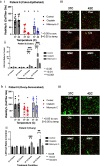Cisplatin exhibits superiority over MMC as a perfusion agent in a peritoneal mesothelioma patient specific organoid HIPEC platform
- PMID: 37468581
- PMCID: PMC10356916
- DOI: 10.1038/s41598-023-38545-4
Cisplatin exhibits superiority over MMC as a perfusion agent in a peritoneal mesothelioma patient specific organoid HIPEC platform
Abstract
Peritoneal mesothelioma (PM) is a rare malignancy with poor prognosis, representing about 10-15% of all mesothelioma cases. Herein we apply PM patient-derived tumor organoids (PTOs) in elucidating personalized HIPEC responses to bypass rarity of disease in generating preclinical data. Specimens were obtained from PM patients undergoing cytoreductive surgery with HIPEC. PTOs were fabricated with tumor cells suspended in ECM-hydrogel and treated with HIPEC regimen parameters. Viability and characterization analyses were performed post-treatment. Treatment efficacy was defined as ≥ 50% viability reduction and p < 0.05 compared to controls. From October 2020 to November 2022, 17 tumors from 7 patients were biofabricated into organoids, with 16/17 (94.1%) sites undergoing comparative 37° and 42° treatments with cisplatin and mitomycin C (MMC). Hyperthermic cisplatin and MMC enhanced cytotoxicity which reduced treatment viability by 25% and 22%, respectively, compared to normothermia. Heated cisplatin displayed the greatest cytotoxicity, with efficacy in 12/16 (75%) tumors and an average viability of 38% (5-68%). Heated MMC demonstrated efficacy in 7/16 (43.8%) tumors with an average treatment viability of 51% (17-92.3%). PTOs fabricated from distinct anatomic sites exhibited site-specific variability in treatment responses. PM PTOs exhibit patient and anatomic location treatment responses suggestive of underlying disease clonality. In PM organoids cisplatin is superior to MMC in HIPEC.
© 2023. This is a U.S. Government work and not under copyright protection in the US; foreign copyright protection may apply.
Conflict of interest statement
The authors declare no competing interests.
Figures





References
Publication types
MeSH terms
Substances
Grants and funding
LinkOut - more resources
Full Text Sources
Medical

